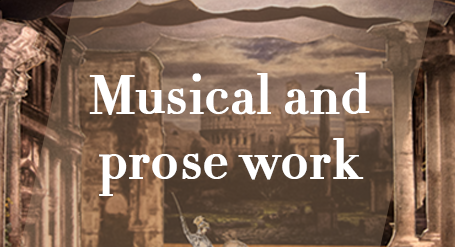
The musical work of Richard Wagner is composed of operas or “musical dramas” ranging from “Fairies” (Die Feen) to “Parsifal”. A detailed presentation of each of these major works is associated here with a set of thematic articles, placing them not only in the context of his personal life but also in his social, economic and cultural context. This section also includes all the musical works (excluding opera) and his literary work.
Tristan and Isolde, WWV90
Tristan und Isolde, WWV90
In short
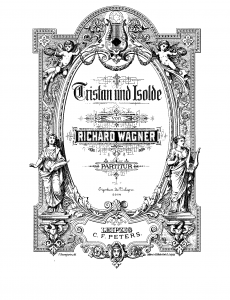 Seventh opera by Richard Wagner, Tristan and Isolde (WWV 90) is the fourth opera created during the so-called maturity phase of the composer and the first conceived under the patronage of King Ludwig II of Bavaria.
Seventh opera by Richard Wagner, Tristan and Isolde (WWV 90) is the fourth opera created during the so-called maturity phase of the composer and the first conceived under the patronage of King Ludwig II of Bavaria.
It is also the only work derived from a command in the career of the composer: on 9 March, 1857, Wagner received a visit from Dr. Enesto Ferreiro-França, emissary of Emperor Dom Pedro II of Brazil who asked Wagner to compose “an opera in the Italian style” in order to get it performed in Rio de Janeiro. Seduced by this command and attracted, as always through his works, by the project to magnify on stage the power of love, Wagner temporarily abandoned the composition of The Ring of The Nibelung (at that time, he was working on the composition of the second act of Siegfried) as well as his project of The Master-Singers of Nuremberg (Die Meistersinger von Nürnberg), of which he had already woven the main plot.
The libretto of this “musical drama” in three acts is inspired by a traditional Celtic legend dating from the XIIth century. Wagner dived into the many sources relating it: the two versions of Gottfried von Strassburg (1205-1210), the continuations of Ulrich von Türheim (1235) and Heinrich von Freiberg (1280), Sir Tristem in Middle English according to Thomas von Erceldoune, Béroul’s Tristan (1180), the lai The Honeysuckle by Marie de France … However, he only made the real project of Tristan in 1854, primarily thanks to three triggers: reading Schopenhauer’s The World as Will and Representation, meeting Mathilde Wesendonck, and finally the competition initiated by his friend Karl Ritter, who had also been thinking about writing a drama about Tristan.
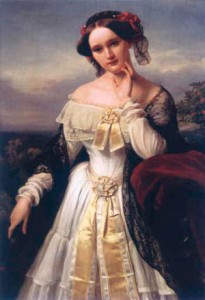 On the philosophical aspect, Wagner took away from Schopenhauer’s thoughts, centered on a pessimistic view of the human condition, the human suffering torn between the desire for death and love. But for the philosopher, the man must kill this will in him by asceticism (in the manner of Buddhists) and negation. Wagner reinterpreted this thought and showed a fusion finally reached in death between the two lovers, under the beneficent veil of the night which holds a central role in the opera.
On the philosophical aspect, Wagner took away from Schopenhauer’s thoughts, centered on a pessimistic view of the human condition, the human suffering torn between the desire for death and love. But for the philosopher, the man must kill this will in him by asceticism (in the manner of Buddhists) and negation. Wagner reinterpreted this thought and showed a fusion finally reached in death between the two lovers, under the beneficent veil of the night which holds a central role in the opera.
The other major source of inspiration for Richard Wagner was his meeting with Mathilde Wesendonck, his muse (also poetess and wife of wealthy merchant Otto Wesendonck), with whom the composer would have had an idyll. When exiled from Saxony and more generally from the German estates for having participated in the Dresden insurrection in 1849, Wagner found refuge in Zurich where he spent nine years where he got acquainted with the Wesendoncks in 1852. Otto, a great admirer of Wagner, became one of his principal patrons and offered him a house on his property which the composer soon nicknamed “the Asylum“. Wagner quickly “fell in love” with Mathilde. This impossible love was directly the source of the drama lived by the protagonists Tristan and Isolde, in other words Richard Wagner and Mathilde Wesendonck. Besides, the musical motifs of two of the Wesendonck Lieder, the set of five melodies composed by Richard Wagner on texts by Mathilde Wesendonck, Träume (Dreams) and Im Treibhaus (In the greenhouse) were included in the musical drama.
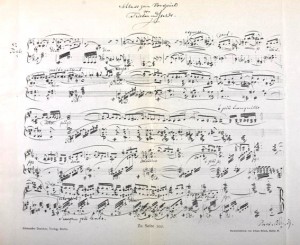 When Tristan and Isolde was finished in September 1857, Wagner offered the manuscript to Mathilde Wesendonck. But his love for the wife of his generous patron was discovered by Minna, who then alerted Otto. The composer was forced to leave Zurich. He completed Tristan and Isolde in Venice in the autumn of 1858, the lugubrious atmosphere of the city during this season, and the plaintive singing of the gondoliers inspiring him with the darkness of the musical composition of the third act.
When Tristan and Isolde was finished in September 1857, Wagner offered the manuscript to Mathilde Wesendonck. But his love for the wife of his generous patron was discovered by Minna, who then alerted Otto. The composer was forced to leave Zurich. He completed Tristan and Isolde in Venice in the autumn of 1858, the lugubrious atmosphere of the city during this season, and the plaintive singing of the gondoliers inspiring him with the darkness of the musical composition of the third act.
The process of staging the work was undoubtedly as hard and as painful as its composition: convinced that only the orchestra of the Vienna Opera was able to interpret one of the most innovative and bold scores of his time, Wagner prepared the rehearsals of Tristan and Isolde in Vienna from 1861. Moreover, Nietzsche worked on the reduction for piano this same year. But following the death of Maximilian II in 1864, the performance of Tristan was cancelled.
But, as everything changed in the life of Richard Wagner from his meeting with King Ludwig II of Bavaria, the fate of the opera also took a new turn. The King indeed demanded that the best instrumentalists compose the orchestra and the best singers of the moment were required to perform the creation which finally took place on 10 June, 1865, in the presence of the composer and his royal patron (the premiere, initially planned on 15 May, had been postponed because Malvina Schnorr von Carolsfeld, who was playing the role of Isolde, had lost her voice the evening of the premiere).
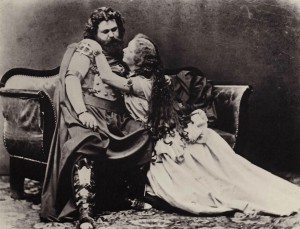
The critics were rather severe towards the opera: it was called “indecent” or even “obscene.” On the other hand, they praised the interpretation of the von Carolsfelds, who gave life to these legendary characters and brought “flesh and blood” to the passion of the mythical couple. But Ludwig Schnorr did not survive long after the premiere of Tristan. An unfounded rumor of malediction ran from then on, and the rumor spread that the artist had died from the incredible efforts made to create Tristan’s “untouchable” role.
Yet the work is a milestone in the history of musical language, notably because of its prelude, presenting the leitmotifs that will be developed throughout the drama. At the very beginning of the work, a strange, dissonant chord (that was later called the “Tristan chord“) seems not to meet the usual harmonic rules. And the same applies with all the work that pushes to its limits the framework of tonality: with Tristan and Isolde, Richard Wagner opened a new door to musical expression which, afterwards, would inspire composers such as Claude Debussy among the French artists, or even the composers of the Vienna School (Arnold Schoenberg, Anton Webern…) who went even further than the audacity initiated with Tristan and Isolde and thus opened the way to dodecaphony.
SB.
If you wish to share further information about this article, please feel free to contact us !
